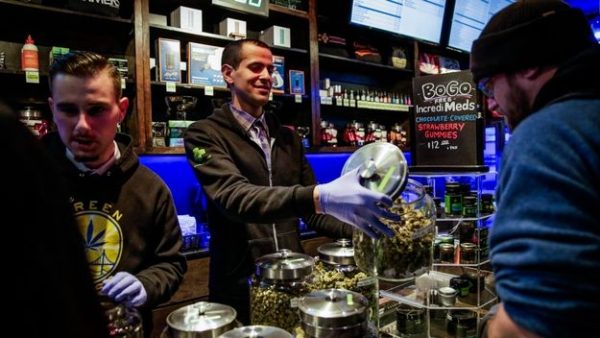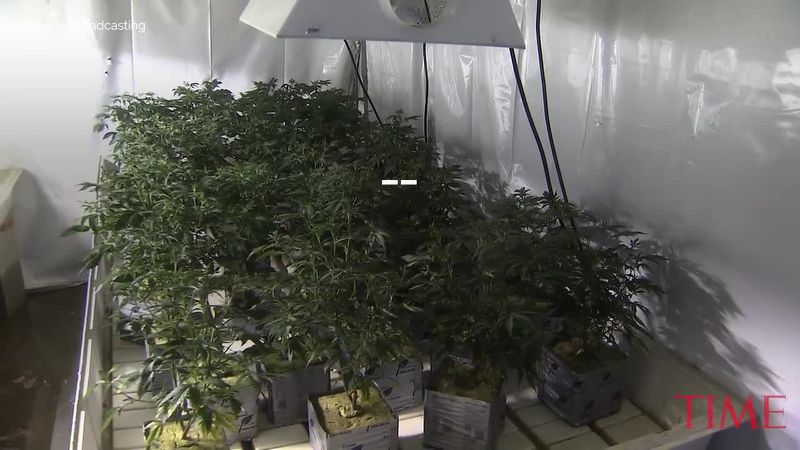One unexpected wrinkle in the emerging market for legal cannabis — rising interest among seniors.
- While most seniors do not use marijuana, the population of older users is rapidly growing.
- Researchers say cannabis has legitimate medicinal uses, yet worry that patients do not receive the right products or doses.
- Some elders have been toking since adolescence, while others are returning to pot after decades of abstinence.
- Products with CBDs, a chemical compound found in cannabis and hemp, are popular with people suffering from arthritis.
- While some seniors use cannabis for pain relief, others are chasing the mellow buzz of their youth.
Green buds, gray consumers: Here’s the full story:
While legal marijuana is new to California, cannabis is an old companion to Lee.
Even before Jan. 1, when California legalized recreational weed, pot was enjoying a gray renaissance. Between 2006 and 2013, the National Survey of Drug Use and Health reported a 250 percent rise in marijuana use by Americans 65 and older. This is still a small number, climbing from 0.4 percent to 1.4 percent of that population, but local dispensaries see plenty of silver-haired shoppers.
“This is probably the most interested — and wariest — group,” said Lincoln Fish, CEO of Outco, noting that the average customer at his Outliers Collective in El Cajon is over 58 years old.
Older consumers add a new wrinkle to the legal cannabis trade. Retirees tend to be less interested in getting high and more interested in getting relief from pain, anxiety and insomnia. Many are skittish about being identified as a user. (Lee and most other seniors interviewed for this story declined to be photographed or give their full names.)
Moreover, a fog of mystery clouds this topic. More research is needed into cannabinoids, marijuana’s active chemical compounds, said Dr. Mark Wallace, chair of the Division of Pain Medicine at UC San Diego Health. Effects vary depending on strains, delivery methods — whether it’s smoked, consumed in brownies and gummies, or administered in tinctures — and the user’s age.
Wallace has no qualms about recommending medical cannabis to his patients. “I’m completely comfortable that it is safe,” he said.
Yet he notes that buying products from a dispensary is a crapshoot. The clerks or “budtenders” are not medical professionals, and seniors often buy products that are too strong or ineffective.
Still, older users — like their younger counterparts — are not exclusively focused on therapy. Some just want to recapture the sweet buzz of youth.
“I smoke every night,” said Terri Graham, 61, a visitor from Wisconsin who had stopped to admire the Cannabus, a black bus with tinted windows that runs from Ocean Beach to a dispensary in Bay Park. “Why not?”
Why?
“It’s the high!”
Endless Christmas
On a recent morning, half the customers inside Torrey Holistics were in their 60s and 70s. Some attended a free Cannabis 101 class on how marijuana products can combat insomnia. Others hoped to ease nagging aches and pains.
That search can be complicated and frustrating. Beth, a 73-year-old Carlsbad resident, originally bought a vape pen to treat her spondylitis, a form of arthritis that targets the spine.
“It was too strong for me,” she said. “I don’t want to get high, I just want to be able to get out of pain.”
This was her second trip to Torrey Holistics, and this time she was considering its edible offerings. “If this doesn’t work,” she said, “I am through.”
Bill, 71, hadn’t bought or used weed for 50 years. That streak ended on this morning, when he purchased cannabis-infused soda, brownies and gummies. He hoped they would reduce the inflammation around his eyelids, a condition known as blepheritis.
Making his dispensary debut, he looked as jittery as a teen buying condoms. But the green buds and sweet fragrance stirred old memories.
“It was hard to go through college in the ’60s without using marijuana,” he said with a laugh.
That’s no exaggeration. In the 1960s and ’70s, Gallup surveyed college students about marijuana usage. Between 1967 and 1971, the number of undergraduates who admitted trying the then-illegal substance zoomed from 5 to 51 percent.
For some, this kindled a lifelong passion.
Walking into Urbn Leaf wearing a faded T-shirt with psychedelic “Yellow Submarine” images, Kerry Durrell looked like Central Casting’s “Aging Hippie.” Now 61, she’s been smoking pot off and on — “I”ve gone through phases” — since 1969.
“It helps me sleep,” she said, inspecting buds at Urbn Leaf. “And it’s recreational.”
For some veteran users, the advent of legal marijuana is like an endless Christmas. Joe, 60, said he’s been smoking weed since his teens. This week, the semi-retired truck driver from Encinitas was thrilled by his first visit to Torrey Holistics.
“Like a kid in a candy shop,” he said. “I just love it.”
Lee, the 70-year-old real estate agent, was equally enthusiastic. Although he grows marijuana at home, he happily bought a pocket-sized pack of edibles for $18.
“The thing I like about buying it here,” he said, “you know what you are getting. When you grow it, sometimes you don’t get high and sometimes you get too high. Here, the quality and consistency seem better.”
Lee’s peers, though, generally frown upon marijuana. In 2010, the Pew Research Center found that only 22 percent of Americans 65 and older favored legalization of marijuana. That number had grown to 30 percent by 2017, but it’s still a minority of seniors.
Among those who disapprove: Bill’s wife. While eager to treat his blepheritis with cannabis-laced soda, he doesn’t expect his spouse to take a sip.
“My wife is too conservative,” he said. “I don’t think she’d indulge.”
Beyond “Easy Rider”
In a classroom at St. Luke’s Episcopal Church in North Park, a dozen men and women formed a circle and reached out to each other.
“I put my hand in yours and together we can do what we could never do alone,” they said in unison. “No longer is there a sense of hopelessness…”
This was the Tuesday night “Beginner’s Meeting” of Marijuana Anonymous, a 12-step program for people whose own marijuana use has become a problem. Getting high, they say, became more important than careers, relationships, responsibilities.
The leader of this meeting was Henry, 58. Before hitting bottom, Henry said, marijuana was the center of his life. Some months, he spent his mortgage money on weed. He credited MA with helping him to recover his self-respect and sense of purpose.
“I’ve been sober for eight years, four months and about 16 days,” he said.
Studies have not shown cannabis to be physically addictive, said Markus Roggen, a chemist and Outco’s vice president of extraction. “But there might be signs of mental addiction,” he said.
When properly dosed, UC San Diego’s Dr. Wallace said, cannabis is often a better choice than more traditional painkillers. “I see medical cannabis as a more conservative treatment than opioids,” he said.
At the university’s pain clinic, he urges patients to shelve any mental images of Grateful Dead concerts or Peter Fonda and Dennis Hopper toking in “Easy Rider.” Instead, he said, cannabis should be seen as another pharmaceutical.
He starts clients on “microdoses,” then adjusts the amount. This is a gradual process, he said, because it is easy to over- and under-prescribe THC, a mood-enhancing and pain-killing compound in marijuana.
“As THC levels go up, the pain will reduce,” he said, “until you get too much THC and then the pain will increase.”
CBD, another cannabinoid or chemical compound within cannabis, has a strong following among seniors, in part because it has no intoxicating effect.
“It’s not about smoking a joint any more,” said Ruthie Edelson, marketing director at Torrey Holistics. That company’s CBD-infused rubbing creams have been embraced by people afflicted by arthritis. “All of our products have a high content of CBD and a very low content of THC. That’s where you get the best medicinal benefit.”
Because CBDs are also found in hemp, products with these cannabinoids have been legal for years. San Diego-based KB Pure Essentials sells CBD-rich massage oils, pain salves, tinctures, deodorants and pet shampoos since 2015.
“We have a bunch of older lady customers,” said KB Pure Essentials co-founder Brooke Brun, who takes a CBD tincture with prescription medicines to control her epilepsy. “A lot of them use it for inflammation, arthritis. A lot take it every day as a wellness supplement.”
Yet Urbn Leaf head buyer Josh Bubeck advises customers they’ll get better results with products containing both CBD and THC. And no matter what seniors buy, he cautions them to go slow.
“The older consumer, some of them haven’t tried cannabis for 30 years,” Bubeck said. “They should start with microdoses. The five milligram gummy has been very popular with the older consumer.”
The family stash
Seniors who are new to cannabis, or returning after a long absence, are vulnerable to overdosing, said Sexton, the naturopathic doctor. Because it takes time to feel marijuana’s full effect, rookies are susceptible to “couch lock.”
“That’s where you don’t want to move,” she said.
While studies indicate that cannabis’ pain-relieving properties are best with a mild 3.4 percent THC content, Sexton said, commercial products are often stronger.
“My patients can’t tolerate 10 milligrams and they don’t need it,” she said. “The doctors aren’t driving this change or deciding what’s available for patients. It’s the people making the products.”
Cannabis isn’t for everyone, which is true for former users as well as marijuana virgins. Researchers have found one’s tolerance for weed changes with age.
Remember Terri Graham, the 61-year-old tourist from Wisconsin who is a nightly user? She made the trip here with her husband, George Graham, who is also 61.
“We probably did all of it at one time or another,” he said. “Bongs, joints.”
These days, though, the family stash is Terri’s alone. “The weed is too strong for me,” George said. “I get too paranoid and think of all the stuff I should be doing.”
credit:sandiegouniontribune.com



